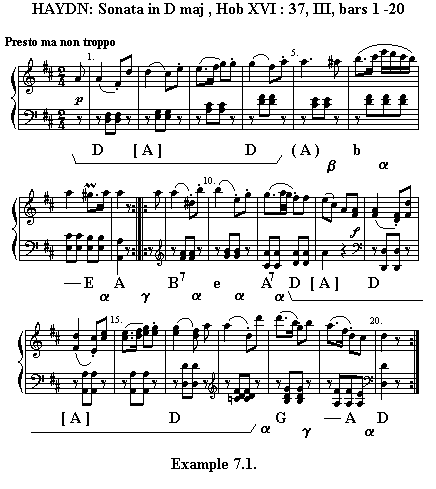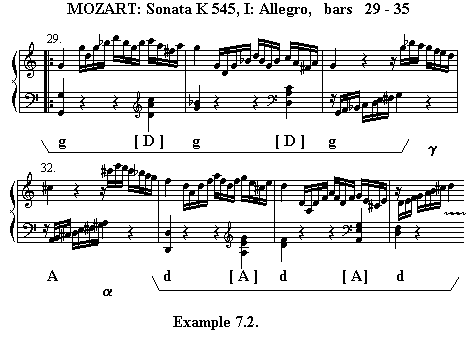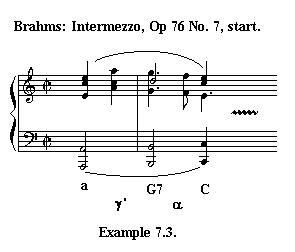
CHAPTER 7 (PART 1)
MODULATION
In this chapter we will consider how modulation works in the context of a theory of chord progressions and syntactic structures.
For a description of some basics on modulation, click here.
Modulation by Dynamic Harmony
As modulation is a process of moving from one tonal center to another
and dynamic harmony
is a movement of chord progressions linking one static
element to another, dynamic harmony and modulation often go hand in
hand.
In the first example, we'll consider an instance where a common chord
is in evidence and in the second example where the modulation is carried
out by a direct movement to the dominant of the new key. Please refer
to the basics of modulation section
for more details of these methods.
The following theme from Haydn's Sonata in D major contains two phrases. The first contains dynamic harmony which modulates from the tonic key to the dominant key and the second phrase contains dynamic harmony which modulates back to the tonic key:
. 
The first phrase is a complete phrase ending in the dominant key (bars 1 to 8). The modulation to the dominant takes place in the dynamic harmony of the closing section where the progression moves the tonality from the tonic D to the cadence in the dominant key of A major. We can describe the modulation from D major to A major by saying that the B minor chord in bar 6 acts as a common chord (or pivot chord) between the two keys. It would thus function as chord VI in D major and simultaneously as chord II in A major. An alternative interpretation is to say that the modulation is carried out by the dynamic harmony which moves the tonality forward from D major to the A major cadence via the chord progression made up of one β progression and one α progression. The third of the E chord is made major so that it can function correctly as the dominant chord in the cadence.
The second phrase is a complete phrase returning to the home tonality. It starts with a dynamic introduction which is responsible for the modulation back to the home key. For this key change, it is not possible to identify a common chord, because, rather than use the B minor chord as a common chord to smooth the movement, Haydn heightens the chromatic effect by using the B7 chord which is not a diatonic chord in either key. A more satisfactory explanation is that the modulation is facilitated by a chord progression constructed by dynamic harmony made up of one γ and two α progressions, as indicated in the example. The third of the B7 chord is made major just as any diatonic minor chord can be made major to strengthen the sense of dynamic movement. It creates a 'transient cadence' in E minor but this key is not established as a new tonal base by any static harmony in E minor.
In the following example from the development section of the first movement of the Mozart K545 sonata, two static elements are connected by a short dynamic element made up of one γ and one α progression. The G minor static harmony of bars 29 to 31 is thus smoothly joined to the D minor static harmony of bars 33 to 35:

The dynamic harmony is constructed just as it would be if it were non-modulating. The third of the A chord in bar 32 is sharpened just as it might be in non-modulating dynamic harmony but in this case the A chord is the dominant chord in the new key. Again, no diatonic common chord is used. In this instance the movement is direct to the new key's dominant chord.
As can be seen from the examples above it is not an individual chord that defines the key but the arrival of the dynamic harmony at a stable tonal position as defined by static harmony or a perfect cadence. Thus, the B7 chord in Example 7.1., at bar 9, does not signify a modulation to E minor since the E minor tonality is not confirmed by static harmony and it is not the end of a phrase. It merely functions as part of the dynamic harmony that carries the movement forward. The A7 chord at bar 11, in contrast, does signify a modulation to D major since the home key is confirmed by 6 ½ bars of static harmony.
A modulation 'direct to the new dominant' is possible for a modulation to any key. This is carried out either by a secondary dominant (a minor or diminished chord converted to a dominant 7th) or via a German augmented 6th chord which is reinterpreted as the dominant 7th chord of the new key. Either method normally takes place within an episode of dynamic harmony.
One important example of 'direct to dominant' modulation is the modulation from a minor key to its relative major. In this instance, the chord progression used is a falling second progression. i.e. a γ' progression. This is a frequent key change in the classical and romantic periods and accounts almost exclusively for the use of this progression in dynamic harmony.
.
This use of this (otherwise uncommon) progression supports the view that modulation functions as a conscious process whereas syntax is largely subconscious.
The book will give more details about 'direct to dominant' modulations. Here we will concentrate on the more common types of modulation.

